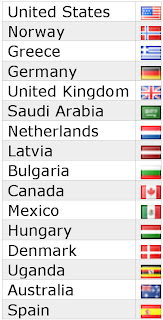
Seasickness
Seasickness is hardly fatal, but with symptoms such as nausea, stomach cramps, and vomiting, it can certainly put a damper on your cruise fun. Motion sickness is thought to be caused by the visual disorientation resulting from being on an object in motion (ship) competing against our body's natural inclination for balance.
Prevention Is Better Than Cure
Diet - to start off with, eat "safe" foods for about a day before boarding (nothing acidic, spicy or fatty) … and don't over indulge (food/alcohol). Eating a light "safe" meal before you board will also help reduce the risk and/or effects of seasickness. Ginger is a great choice!
The motion sickness patch is probably the most popular these days - to be placed behind your ear 4 hours before boarding and changed if necessary after 72 hours. This is quite an effective way to prevent seasickness but causes things like a dry mouth and blurry vision. Better to be thirsty than sick, though! The active ingredient, scopolamine, is absorbed through the skin.
Over the counter medication (usually causes some drowsiness) - to be taken 1-2 hours before boarding. The most recommended are pills with the active ingredient meclizine (less-drowsy Dramamine, Bonine, Antivert), then pills with the active ingredient Dimenhydrinate (Dramamine regular). Marezine (cyclizine) and Stugeron (cinnarizine) seem to be less sleep inducing than all of the above. Other popular antihistamines (Benadryl - diphenhydramine based) also work for some people. (Money saving tip: ask your pharmacist for the generic version of the medication you wish to take.)
Acupressure bracelets - a drug-free product causing no side effects - the motion sickness band is worn one on each wrist for the duration of your trip. Some contain small magnets, others just a stud, which should be aligned with a pressure point (P6) on your wrist and pressure applied periodically. This won't work very well if you "miss" the pressure point.
.
How to Get Relief
.
The easiest and most economical way to stop sea sickness is to walk. This is what is meant by getting your sea legs. When you walk around a moving ship the fluid in your inner ear learns the motion of the ship in a controlled way. When you feel sea sickness coming on walk,walk,walk. The worst thing you can do is take to your bed. Lying down will make your nausea worse. Once your body becomes accustomed to the motion you will no longer feel ill and will be able to sit and lie down when you want to.
DO:
Look out the window (or better yet, go onto the deck and to the centre of the ship, facing forward) at a distant, stable object, like the horizon. The centre of the ship, close to the waterline, is the most stable part of the ship.
Use a fan or listen to some music… this will get your mind off things.
Eat some salty snacks with regular intervals to help dry up your stomach.
Relax if you can - lying down and closing your eyes might help.
Ginger is a natural remedy to general nausea and sea sickness. Drink ginger beer or tea, or eat fresh ginger, a cookie or suck on a ginger sweet (like Gin Gins) to help combat your green cheeks. Try Sailor's Secret, a branded ginger capsule or Quesy Pops, popsicles containing essential oils from natural herbs and aromatherapy in ginger flavour but also others like lavender, peppermint, etc. Any ginger product is most effective if taken before boarding.
Some motion sickness medicine (e.g. Dramamine patches) may help to reduce the nausea at this stage. Maybe one of the most effective if you're severely seasick and vomiting, is heavy duty Phenergan Suppositories. (That's one of those too sick to care I just want relief things. Like childbirth.)
DON'T:
Read or watch television once the sea sickness has kicked in, it will make you feel worse.
Drink big gulps of water. Tiny sips at intervals are better.
Face backwards.
.
Conclusion:
For many people, seasickness won't be an issue. These days cruise ships are very stable; in fact most are fitted with stabilizers to ensure your voyage is as smooth as possible. Voyager of The Seas has an Azipod propulsion system. This system pushes rather than pulls the ship through the water which reduces motion and creates much less vibration. It also has the added benefit of allowing sharper turns for the ship without causing a lean. Coupled with weather forecasts which enable captains to plan their route away from rough waters, seasickness shouldn't be a big concern.
.
Just for Fun:
What's your favorite term for getting sick?











